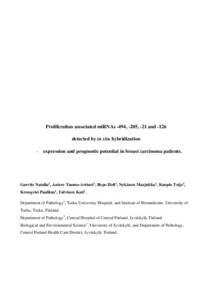Proliferation-associated miRNAs-494, -205, -21 and -126 detected by in situ hybridization: expression and prognostic potential in breast carcinoma patients
Natalia Gurvits; Tuomo‑Artturi Autere; Heli Repo; Marjukka Nykänen; Teijo Kuopio; Pauliina Kronqvist; Kati Talvinen
https://urn.fi/URN:NBN:fi-fe2021042718744
Tiivistelmä
Purpose
To
visualize by in situ hybridization (ISH) the levels of a set of
proliferation-associated miRNAs and to evaluate their impact and
clinical applicability in prognostication of invasive breast carcinoma.
Methods
Tissue
specimen from breast carcinoma patients were investigated for
miRNAs-494, -205, -21 and -126. Prognostic associations for levels of
miRNAs were analyzed based on complete clinical data and up to 22.5-year
follow-up of the patient material (n = 285). For detection of the miRNAs, an automated sensitive protocol applying in situ hybridization was developed.
Results
MiRNA-494
indicated prognostic value for patients with invasive breast carcinoma.
Among node-negative disease reduced level of miRNA-494 predicted
8.5-fold risk of breast cancer death (p = 0.04).
Altered levels and expression patterns of the studied miRNAs were
observed in breast carcinomas as compared to benign breast tissue.
Conclusions
The
present paper reports for the first time on the prognostic value of
miRNA-494 in invasive breast cancer. Particularly, detection of
miRNA-494 could benefit patients with node-negative breast cancer in
identifying subgroups with aggressive disease. Based on our experience,
the developed automatic ISH method to visualize altered levels of
miRNAs-494, -205, -21 and -126 could be applied to routine pathology
diagnostics providing that conditions of tissue treatment, especially
fixation delays, are managed.
Kokoelmat
- Rinnakkaistallenteet [27094]
